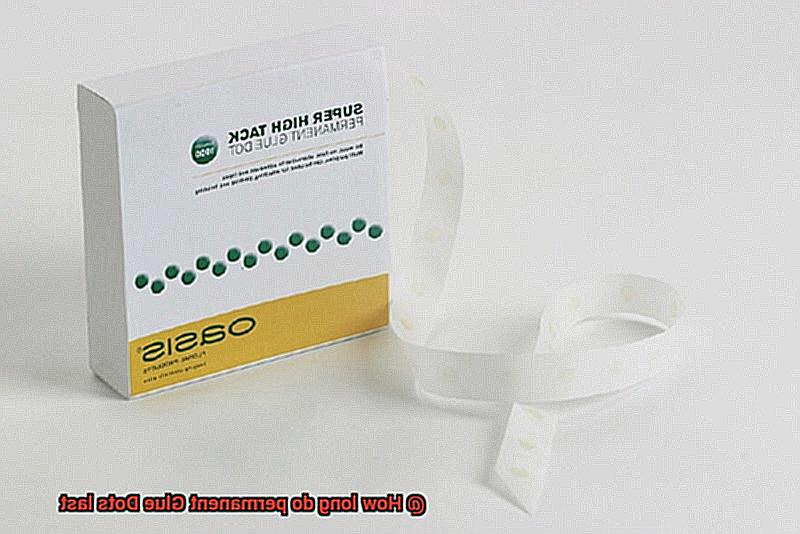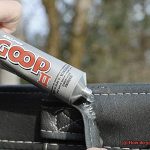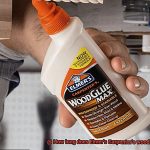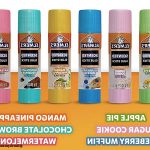Picture this: you’re in the middle of a crafting frenzy, trying to piece together your latest masterpiece. Or perhaps you’re knee-deep in packaging materials, determined to create a flawless presentation for your products. In both scenarios, one thing is certain – you need an adhesive that won’t let you down.
Enter permanent Glue Dots®, the unsung heroes of the adhesive world. These tiny dots have earned their stripes in countless industries and applications, becoming a go-to choice for anyone seeking a steadfast bond. But just how long can these little wonders hold on?
In this captivating blog post, we embark on a journey into the realm of adhesive longevity, shedding light on the remarkable staying power of permanent Glue Dots. We’ll delve into their composition, uncover factors that can influence their lifespan, and equip you with the knowledge needed to tackle any project with confidence.
So fasten your seatbelts as we unravel the mysteries surrounding Glue Dots. Get ready for an expert analysis of their endurance and discover tips and tricks to maximize their adhesive potential. From quick fixes to long-lasting creations, it’s time to unleash the true power of these adhesive dots and understand why they deserve a permanent spot in your toolbox.
What are Permanent Glue Dots?
Contents
- 1 What are Permanent Glue Dots?
- 2 Factors that Affect the Longevity of Permanent Glue Dots
- 3 The Adhesive Used in Permanent Glue Dots
- 4 The Performance of Permanent Glue Dots Vary Depending on the Application and Conditions
- 5 How to Ensure Optimal Performance and Longevity of Permanent Glue Dots
- 6 Regular Maintenance and Cleaning of Bonded Surfaces
- 7 Replacing a Weakened or Lost Adhesion of Permanent Glue Dots
- 8 Conclusion
When it comes to unleashing your creativity or tackling everyday tasks, finding the perfect adhesive is key. Look no further than Permanent Glue Dots, the versatile and reliable solution beloved by crafters, DIY enthusiasts, and professionals everywhere. In this article, we will delve into the world of Permanent Glue Dots, exploring their composition, application, and unique advantages that make them the go-to choice for any project.
What are Permanent Glue Dots?
Picture this: small, round dots infused with a pressure-sensitive adhesive, all sitting snugly on a release liner. These are Permanent Glue Dots – the champions of bonding. Crafted to provide an unyielding grip on an array of surfaces, from paper to plastic, metal to fabric, Permanent Glue Dots have got you covered.

How do they work?
Using Permanent Glue Dots is as effortless as peel, press, and bond. Gently peel a dot from the liner and firmly press it onto your desired surface. In an instant, a formidable bond is formed. Gone are the days of messy liquid glues; with Permanent Glue Dots, precision reigns supreme. Complete control over dot quantity and placement ensures flawless application every single time.
Why choose Permanent Glue Dots?
- Versatility: From crafting masterpieces to conquering household or office tasks, Permanent Glue Dots adapt to any project with ease.
- Flawless Finish: The transparent and residue-free adhesive guarantees a clean and professional look.
- Unyielding Strength: Thanks to their robust formula, Permanent Glue Dots provide unwavering adhesion even under pressure or movement.
- Size and Strength Options: With an array of dot sizes and strengths available, selecting the perfect dot for your specific needs has never been easier.
- Convenience: Bid farewell to sticky fingers and hello to hassle-free application. Permanent Glue Dots eliminate the chaos and inconvenience of traditional liquid adhesives.
Factors that Affect the Longevity of Permanent Glue Dots
The longevity of permanent Glue Dots is influenced by several factors, and understanding these factors can help maximize the lifespan of your adhesive. Let’s explore these factors in depth.
- Surface Type: The type of surface on which you apply the Glue Dots plays a crucial role in their longevity. Smooth and clean surfaces, like glass or metal, provide a better adhesive bond and make the Glue Dots last longer. On the other hand, rough or porous surfaces, such as fabric or wood, hinder adhesive strength and reduce the lifespan of the Glue Dots.
- Temperature and Humidity: Environmental conditions, specifically temperature and humidity, significantly impact the lifespan of permanent Glue Dots. Extreme temperatures, whether too hot or too cold, weaken the adhesive bond and cause the Glue Dots to lose effectiveness over time. Similarly, high humidity levels affect the adhesion properties, leading to a shorter lifespan.
- Weight and Pressure: The weight and pressure applied to an object secured with permanent Glue Dots influence their longevity. If the weight exceeds the recommended limit for the specific type of Glue Dot used, it may result in premature failure of the adhesive bond. Additionally, inadequate pressure during application leads to weak adhesion and reduced durability.
- Chemical Exposure: Exposure to certain chemicals or solvents deteriorates the adhesive properties of permanent Glue Dots. Cleaning agents, oils, or paints can weaken or dissolve the adhesive, causing the Glue Dots to lose their grip over time. It is essential to consider potential chemical exposure when using permanent Glue Dots in various applications.
- Storage Conditions: Proper storage is crucial in maximizing the longevity of permanent Glue Dots. Storing them in a cool, dry place away from direct sunlight or extreme temperature fluctuations maintains the integrity of the adhesive and ensures their effectiveness for an extended period.
- Application Technique: The way you apply permanent Glue Dots impacts their lifespan. Following the manufacturer’s instructions and applying the Glue Dots evenly and firmly onto the desired surface is crucial. Inadequate application technique, such as insufficient pressure or improper placement, results in weak adhesion and reduces the longevity of the Glue Dots.
The Adhesive Used in Permanent Glue Dots
The adhesive used in permanent Glue Dots is a pressure-sensitive adhesive (PSA), known for its ability to form a strong bond when pressure is applied. This type of adhesive is commonly found in various crafting, home, and office applications. The composition of the adhesive may vary depending on the manufacturer, but most Glue Dots are made from synthetic polymers, tackifying resins, and other additives.
Synthetic polymers, such as acrylics or rubber-based materials, provide strength and flexibility to the adhesive. These polymers enable the Glue Dot to adhere well to different materials and withstand various conditions. Tackifying resins are added to enhance the adhesive’s tackiness, ensuring a strong bond between surfaces.
One advantage of using permanent Glue Dots is their long-lasting adhesion. They are designed to be difficult to remove once applied, making them suitable for projects that require a strong bond. Additionally, permanent Glue Dots are resistant to moisture and temperature changes, making them suitable for both indoor and outdoor use.
However, it is important to note that the bond strength of a Glue Dot may weaken over time, especially if exposed to extreme conditions or mechanical stress. Removing a permanent Glue Dot may require some effort and could leave behind residue on the surface. To avoid any potential issues, it is always recommended to test the adhesive on a small area before applying it on a larger scale.
The Performance of Permanent Glue Dots Vary Depending on the Application and Conditions
The performance of permanent glue dots can vary greatly depending on the specific application and the conditions in which they are used. There are several key factors that can impact the effectiveness of these adhesive wonders, and understanding them is crucial for achieving optimal results.
Firstly, the surface texture plays a significant role in how well glue dots adhere. Smooth and non-porous surfaces like glass or plastic provide an ideal foundation for strong adhesion. However, rough and porous surfaces such as fabric or wood may pose a challenge. When selecting the appropriate glue dot strength for your application, it’s important to consider the surface texture to ensure a secure bond.
Another important consideration is the weight or load that the glue dot needs to bear. Glue dots come in various tack levels or strengths, and choosing the right strength for your project is crucial. Using a permanent glue dot with lower tack strength to hold a heavy object may result in inadequate adhesion and a less-than-desirable outcome.
Additionally, environmental conditions can have a significant impact on glue dot performance. Extreme temperatures or high humidity levels can weaken the adhesive properties, causing them to lose their grip or peel off. It’s always advisable to refer to the manufacturer’s instructions and recommendations regarding optimal temperature and humidity ranges when using permanent glue dots.
Furthermore, exposure to sunlight and certain chemicals can also compromise the adhesive strength of permanent glue dots. Prolonged exposure to sunlight can degrade the adhesive over time, leading to reduced adhesion strength. Similarly, certain chemicals or solvents may react with the adhesive, weakening its bonding properties. To ensure maximum longevity of your glue dots, it’s essential to protect them from prolonged sunlight exposure and avoid contact with chemicals or solvents that could compromise their adhesive strength.
How to Ensure Optimal Performance and Longevity of Permanent Glue Dots
Permanent Glue Dots are more than just adhesive dots – they are sticky little wonders that can hold things together for a long time. But did you know there are some simple tricks to make them work even better? Here are some tips to ensure the optimal performance and longevity of your permanent Glue Dots.
Proper Storage
Like any good ingredient, Glue Dots need a good home. Store them in their original packaging or in an airtight container away from sunlight and extreme temperatures. This will help them stay fresh and sticky for longer, ensuring their effectiveness when you need them most.
Surface Preparation
Before applying Glue Dots, prepare the surface properly. Clean it thoroughly, ensuring it is dry and free from any dirt or oil. A clean surface helps the Glue Dots adhere better and last longer. Use soap and water or rubbing alcohol to remove any contaminants that might interfere with the adhesion.
Firm Application
When it’s time to stick those dots, press them firmly onto the surface. Don’t be gentle – give them a good squeeze. This activates the glue and makes it stickier, creating a stronger bond. Use your fingers or even a roller to ensure the dots are stuck down properly.
Environmental Considerations
Glue Dots don’t like extreme temperatures or humidity. They prefer a nice, cozy environment. Avoid using them in super hot or cold places, or where it’s really humid. They work best in a controlled environment with moderate temperatures.
Reinforcement when Needed
Sometimes, you might need some extra support for your project. If you’re sticking heavy things together or working with tricky surfaces, you can use tape or other adhesives alongside Glue Dots for extra strength. This additional reinforcement will provide added durability and ensure that your bonded items stay together securely.
Remember to periodically check your bonded items to ensure they are still firmly attached. If you notice any issues, such as the bond weakening or coming apart, it’s time to reinforce or reapply the Glue Dots. By following these guidelines, you can maximize the effectiveness of your permanent Glue Dots and ensure long-lasting adhesion.
Regular Maintenance and Cleaning of Bonded Surfaces
Maintaining the adhesive strength of Glue Dots requires regular maintenance and cleaning of bonded surfaces. Dirt, dust, debris, and certain substances like oils and greases can compromise the bond, so it’s important to keep those surfaces clean. Here’s a step-by-step guide to help you keep your Glue Dots performing at their best.
First, grab a soft brush or cloth and gently remove any loose dirt or debris from the surface. We don’t want those particles scratching our lovely bonded area during the cleaning process. Avoid using abrasive materials or harsh chemicals that could damage both the surface and the adhesive properties of your Glue Dots.
Now it’s time to get cleaning. Prepare a mild detergent or soap solution with water and use a soft cloth or sponge to gently wipe the surface in a circular motion. No aggressive scrubbing here. We want to prevent damage and preserve that adhesive strength. Take your time and be thorough in your cleaning.
After a good wipe-down with the detergent solution, rinse the surface thoroughly with clean water to remove any lingering residues. Remember, any soap or detergent left behind can compromise your Glue Dots’ adhesive power. So make sure to rinse well.
Lastly, be sure to dry the surface completely before reapplying your trusty dots. Moisture can affect the adhesive strength, so take the time to dry it properly. You can use a clean cloth or let it air dry naturally.
Some surfaces may require extra attention due to stubborn stains or adhesive residue. In these cases, specialized cleaning products designed for that purpose may come in handy. Just make sure to check if they’re safe to use on your specific surface before going all-in.
Replacing a Weakened or Lost Adhesion of Permanent Glue Dots
We’ve all experienced that moment of frustration when the adhesion of our trusty permanent glue dots weakens or, even worse, disappears altogether. But fear not, my friend. I’m here to share some simple and effective steps to help you replace that weakened or lost adhesion.
Step 1: Clean is King
Surface contamination is the number one culprit behind weakened adhesion. Before applying a new glue dot, take a moment to clean the surface thoroughly. Use a soft cloth or brush to remove any dirt, oil, or dust that may be lurking around. Trust me, a clean surface is the secret sauce to a successful bond.
Step 2: Temperature Matters
Extreme temperatures can seriously mess with the effectiveness of your glue dots. Make sure you’re storing and using them in a controlled environment. Avoid exposing them to arctic cold or desert heat. Remember, your glue dots prefer a cozy and stable temperature.
Step 3: Out with the Old, In with the New
If your glue dot has lost its mojo or vanished into thin air, it’s time for a replacement. Start by cleaning the surface again to remove any residue from the previous dot. Then, grab a fresh glue dot and apply it to the desired area. Align it properly and press it firmly onto the surface for optimal adhesion. Don’t be shy – give it a good squeeze.
Step 4: Explore Alternatives
Sometimes, certain surfaces just aren’t suitable for glue dots. In those cases, you might want to consider alternative methods like adhesive sprays or tapes. These can work wonders when traditional glue dots aren’t cutting it. Be open-minded and willing to experiment with different adhesive options.
Step 5: Prevention is Key
To prevent future adhesion woes, follow the manufacturer’s instructions diligently. Store your glue dots in an appropriate environment, away from extreme temperatures and excessive moisture. Give them the love and care they deserve, and they’ll stick by your side (literally) for a long time.
Remember, different surfaces may require different adhesives. If you’re working with special materials like fabric, plastic, or metal, make sure you have the right glue dots for the job. And if you consistently face adhesion issues, it might be time to explore other adhesive options or seek professional advice.
wQTEo5EQzmk” >
Conclusion
In conclusion, permanent Glue Dots are the ultimate adhesive solution, offering a bond that stands the test of time. The lifespan of these adhesive dots is influenced by a multitude of factors – from surface type to temperature and humidity conditions, weight and pressure applied to chemical exposure, storage conditions, and application technique.
To unleash the full potential of permanent Glue Dots and extend their longevity, proper storage is paramount. Keep them cool and dry, shielding them from extreme temperatures and sunlight. For a strong bond, don’t forget to prep your surface diligently – clean it thoroughly and ensure it’s dry before applying the dots. And remember: firm pressure during application activates the adhesive magic.
Environmental factors can also play a role in the performance of permanent Glue Dots. High humidity or scorching temperatures may weaken their adhesive prowess. Additionally, sunlight or certain chemicals can compromise their bonding strength. Be mindful of these elements when using Glue Dots for optimal results.
Regular maintenance is key to preserving the adhesive strength of Glue Dots over time. Keep those bonded surfaces squeaky clean by removing dirt, debris, and contaminants. If adhesion starts to wane or disappears entirely, fear not. Simply replace the old dot with a fresh one after giving the surface a thorough cleaning.
By adhering (pun intended) to these guidelines and considering your project’s unique requirements, you’ll unlock the true power of permanent Glue Dots – ensuring they become an indispensable tool in your crafting, packaging, or DIY endeavors.






